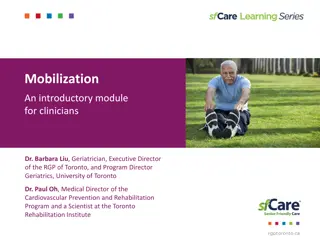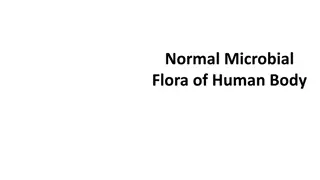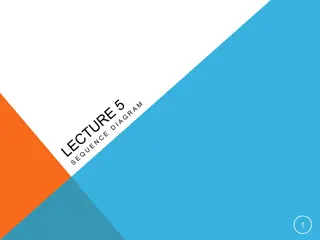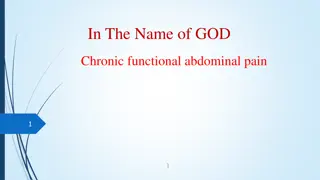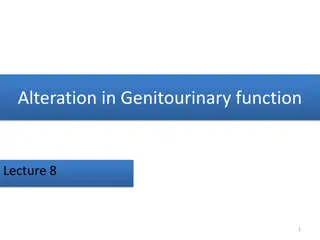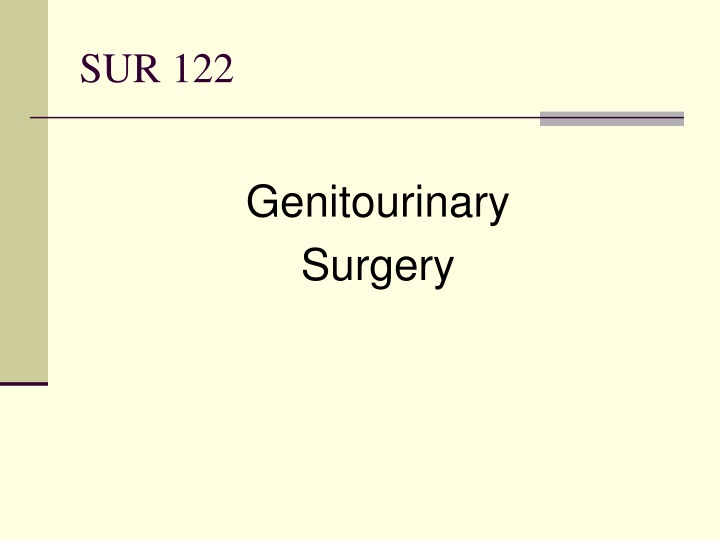
Comprehensive Guide to Genitourinary Surgery and System Terminology
Explore the world of genitourinary surgery, anatomy, pathology, and terminology. Learn about common conditions like BPH, hydrocele, and more. Discover the intricacies of the male reproductive system, including the testis lobules and functions of different cell types. Dive into pre-operative testing, anesthesia, and post-operative care in this informative resource.
Download Presentation

Please find below an Image/Link to download the presentation.
The content on the website is provided AS IS for your information and personal use only. It may not be sold, licensed, or shared on other websites without obtaining consent from the author. If you encounter any issues during the download, it is possible that the publisher has removed the file from their server.
You are allowed to download the files provided on this website for personal or commercial use, subject to the condition that they are used lawfully. All files are the property of their respective owners.
The content on the website is provided AS IS for your information and personal use only. It may not be sold, licensed, or shared on other websites without obtaining consent from the author.
E N D
Presentation Transcript
SUR 122 Genitourinary Surgery
Genitourinary System Terminology Anatomy & Physiology Pathology Diagnostic & Pre-operative Testing Anesthesia & Medications Basic Instrumentation, Supplies, & Equipment Incision Site Options Positioning, Prep, & Draping Dressings, Drains, & Post-operative Care
Terminology BPH nonmalignant enlargement of prostate common with age Dialysis - waste product removal from the blood of a patient in renal failure Enucleate remove without cutting into Epispadias urethra terminates on the dorsal surface of penis (on top of) or above clitoris (congenital) Gerota s capsule perirenal fascia that holds kidney in place Impotence inability to achieve erection Hematuria blood in the urine Hilum- everything enters and leaves kidneys through this notch Ptosis drooping of an organ or part Trigone triangle-like space a bladder base
Terminology Hydrocele fluid filled sac in the scrotum Hypospadias urethra opens on ventral surface (underneath) of penis, perineum, or inside the vagina (congenital) Paraphimosis retraction of prepuce results in painful swelling of glans Phimosis uncircumcised male prepuce won t retract from glans Wilm s tumor - malignant neoplasm of a kidney in children 3-4yrs.
Anatomy video http://www.youtube.com/watch?v=xYTjvqzyd 9k
Male Reproductive System Large part external to body cavity Scrotum=pouch of skin that contains testis Testis are both endocrine & exocrine glands Exocrine=secrete sperm via ducts Endocrine glands produce testosterone
Male Reproductive System Testis Lobules with 3 cell types: 1. Seminiferous tubules involved in spermatogenesis 2. Interstitial cells (cells of Leydig) produce testosterone 3. Seratoli cells provide nutrients for sperm
Male Reproductive System Sperm Male produces 300 million sperm per day=120million per ml Less than 20 million per ml considered sterile
Male Reproductive System 2. Midpiece extension that contains large amt of mitochondria (ATP) 3. Flagella tail composed of a protein that allows for movement generated by ATP Sperm (3 parts) 1. Head a. Acrosome contains chemical hyaluronidase which is an enzyme that breaks down hyaluronic acid (found in loose connective tissue) that allows sperm to penetrate the egg b. Nucleus (haploid) contains 23 chromosomes (when unites with egg also 23 chromosomes, chromosome total becomes 46) 1 N
Male Hormones 1. FSH Tells interstitial cells to produce testosterone and sperm in testis 2. LH Tells interstitial cells to develop and secrete testosterone 3. Testosterone Stimulates development, growth and maintenance of male reproductive system including sex characteristics, maturation of sperm, and skeletal muscle development
Ducts 1. Epididymis Series of ducts or channels that communicate with the testis Store sperm Area for sperm maturation Ciliated columnar cells secrete 2. Vas Deferens Loops up over bladder Transports sperm Ciliated columnar cells and smooth muscle (peristalsis) move sperm 3. Ejaculatory duct Vas deferens merge into this posterior to bladder which merges with the urethra (runs through the prostate)
Male Reproductive System Summation Testis are located in the scrotum Testes produce sperm and testosterone Contain lobules containing seminiferous tubules where sperm arise Lobules lead to ducts in the epididymis Epididymis leads to ductus deferens Ductus deferens open into urethra Testis suspended by spermatic cord Spermatic cordgoes from inguinal ring to testis Inguinal ring also contains ductus deferens, testicular vessels (arterial, venous, and lymphatic), and nerves
Accessory Organs Seminal vesicles Behind (posterior) bladder Secrete into ejaculatory duct 60% liquid portion of semen Prostate gland Donut shaped as urethra runs through it Secretes 30% liquid portion of semen directly into the urethra Bulbourethral (Cowper s) glands 10% volume of semen (lubricates head) Neutralizes acidity of urethra Secrete directly into urethra 1. 2. 3. Internal urinary sphincter tightens w/ejaculation to prevent mixing of urine w/sperm
Accessory Organs Penis 3 cylindrical tissue masses Corpus cavernosum x 2 (upper) Corpus spongiosum x1 (lower) Urethra passes through corpus spongiosum These three areas are surrounded by blood sinuses Arteriole blood retention allows an erection Post-ejaculation pressure is released
Genitourinary System Kidneys Adrenal glands Ureters Urinary Bladder Urethra Prostate Gland (male)
Kidneys Location retroperitoneal At T-12 to L-3 vertebral column Encapsulated in perineal fat and fascia renalis capsule which hold them in position Hilum medial area where renal artery and vein enter and exit Left larger Right lower due to liver location Functional unit is the nephron: filtration, reabsorption, secretion
Nephron > 1 million per kidney 2 types: juxtamedullary and cortical Each composed of capillary network: Renal corpuscle Renal tubule
Nephron Renal Corpuscle: Bowman s Capsule Glomerulus Renal Tubule: Proximal Convuluted Tubule Loop of Henle Distal Convuluted Tubule Collecting Tubule
Renal Corpuscle 1. Filtration Bowman s Capsule (glomerulus encased by) Glomerulus (capillary network) Water and substances filtered from blood
Renal Tubules 2. Reabsorption Substances move from renal tubules into capillaries (blood) surrounding the tubules Prevents needed body substances from being lost in urine Proximal convuluted tubule (origin in Bowman s Capsule) Loop of Henle Distal Convuluted Tubule
Renal Tubules Secretion Substances move from blood into tubules (urine) Distal Collecting Tubule Collecting Tubule 3.
Filtrate/Urine Pathway Fluid once it leaves the blood and is in the nephron called filtrate, once leaves nephron is called urine Nephron > papillary duct > minor and major calyces > renal pelvis > ureters
Urinary Bladder Holds average of 800ml Three layers: Submucosa, Muscularis, Inner Tunica Mucosa Muscularis called detrusor muscle Internal sphincter = smooth muscle = involuntary control External sphincter = skeletal muscle = voluntary control Stretch receptors in bladder signal brain via micturation reflex About 400ml, brain relaxes internal sphincter This signals you it s time to go Inner Tunica mucosa is rugae surface (allows for stretching) except in the trigone area which is a smooth surface
Adrenal Glands (Suprarenal) Job to augment the Sympathetic Nervous System division of the Autonomic Nervous System Endocrine glands: contain cortex and medulla Cortex: secretion of fluid and electrolyte balance controlling steroids and hormones (aldosterone and cortisol) Medulla: produces, stores, & secretes epinephrine (adrenaline) & norepinephrine (noradrenalin)
Adrenal gland (cortex) Aldosterone- decreases urine output as it stimulates renal tubules to reabsorb water and salts (sodium reabsorption) Most active hormone Indirectly regulates: Electrolyte levels (bicarbonate, potassium, chloride) Blood pressure Blood volume pH levels
Adrenal gland (cortex) Adrenal gland (cortex) Cortisol (hydrocortisone) Affects glucose metabolism Regulates metabolism of fats, carbohydrates, proteins, fats, potassium Anti-inflammatory
Adrenal gland (medulla) Adrenalin (epinephrine) Constricts visceral vessels Dilates skeletal muscles Dilates bronchiole musculature Increases glucose production Decreases GI activity Increases heart rate
Adrenal gland (medulla) Norepinephrine Increases blood pressure Decreases heart rate Constricts vessels (arterioles and venules)
Pathology of the Male Reproductive System Phimosis Hypospadias/Epispadias BPH Cancer of the Prostate Cryptorchidism Testicular Torsion Testicular Cancer Trauma
Phimosis Foreskin will not retract Congenital Geriatric Can cause infection, pain Tx: circumcision
Hypospadias Epispadias Hypospadias Urethral opening under the penis (ventral) or on the perineum Urethral opening inside the vagina Congenital Tx: Surgical repair Epispadias Urethral opening on top of the penis (dorsal) Urethral opening above the clitoris Congenital Tx: Surgical repair
Cryptorchidism Failure of testes to descend into scrotum after 1 yr of age Found in abdomen or groin Often seen with inguinal hernia Premature birth Tx: HCG hormone therapy Orchiopexy Orchiectomy
Testicular Torsion Spermatic cord is twisted Tx: Orchiopexy
Testicular Cancer 20-40yrs Infants with cryptorchidism higher risk Embarrassment leads to non-treatment which allows progression of disease Tx: Orchiectomy Sperm may be stored Testicular implants available for cosmetic purposes
BPH Hypertrophy Normal part of aging > 50 yrs Urethral narrowing can result Tx: Drug therapy prostate growth (medical) TURP (surgical)
Prostate Cancer > 50 yrs Asymptomatic in early stages of disease Symptom of blood in the urine, likely too late PSA (prostate specific antigen) Normal value <4ng/mL PSA laboratory test of choice by men over 50 for early detection Will be done if BPH detected on digital exam to r/o cancer PSA f/u with biopsy
Pathology of the Urinary System Bladder Tumors Urinary Calculi Polycystic Kidney Disease Diabetic Nephropathy ESRD Renal Cell Carcinoma Congenital Nephroblastoma (Wilm s Tumor)
Urinary Calculi/Stones Solid particles that form in one or both kidneys May become lodged Pass < 4mm stones 80% of the time 50% recurrence rate 3 types: Calcium (75%) dietary imbalance/hyperparathyroidism Magnesium ammonium phosphate (struvite) (15%) UTI Uric Acid (6%) associated with gout Cystine amino acid reabsorption failure
ESWL Extra-Corporeal Shock-Wave Lithotripsy Renal Calculi Historical: Done in large tub and patients were intubated and connected to the shock therapy unit Present: Water-bed like unit under lower body. Stone lined up with C-arm machine/cross-sectioned + Stone hit with shock waves precisely Avoid bone Shocks gauged to match patient HR, otherwise patient can experience arrhythmias if shock wave exceed HR Usually range from 120/min to 60 /min
Other Methods of Stone Removal Cystoscopic / ureteroscopic / nephroscopic lithotomy Direct extraction via Laser through Small Lithotripsy unit used through Percutaneous lithotomy Open lithotomy
Polycystic Kidney Disease Multiple fluid filled cysts in parenchyma of kidney One kidney could have thousands Kidney could weigh up to 22lbs. 3 Types: 1. Autosomal dominant (hereditary) 30-50yrs 90% 2. Autosomal recessive (rare/congenital) Children 3. Acquired (long term kidney problems)
Diabetic Neuropathy (sclerosis) Uncontrolled diabetic Progressive disease>ESRD>dialysis












